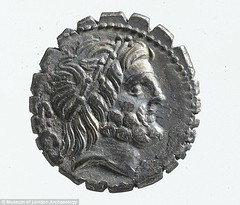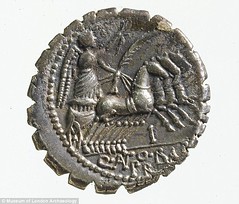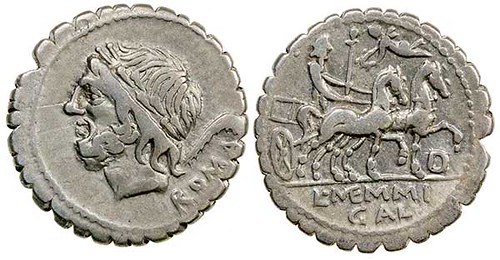
PREV ARTICLE
NEXT ARTICLE
FULL ISSUE
PREV FULL ISSUE
ROMAN SERRATED DENARIILast month we discussed the term "hot shortness": "Cracks or notches around edges of cast blanks caused by different melting points of impurities. Ancient coins
often display evidence of such hot shortness." Eric Schena disagreed with the particular coin Dick Johnson used to illustrate his definition. Having been away for a few weeks, Bob Leonard notes
the same problem. -Editor
  Bob Leonard writes: I wouldn't challenge Dick Johnson on a minting term, but this is certainly not an example of Hot Shortness; it's a serrate denarius of the Roman Republic, with the edges deliberately notched prior to striking. And it is of virtually pure silver, with negligible lead content. Bob provided a couple online reference for more information. Thanks! The first is by Robert Kokotailo of the Calgary Coin Shop. -Editor
 This Roman Republican denarius was issued by L. Memmius Galeria in about 106 BC. The obverse depicts the right facing head of Saturn with ROMA behind. The reverse depicts Cupid flying over a biga driven right by Saturn, with "L. MEMMI GAL" in two lines below. The edge of this coin is serrated. Serrated denarii are unique to the Roman Republic with most issued from the late 2nd to early 1st century BC. While relatively common, after more than 200 years numismatists have not agreed on why some types of Republican denarii are serrated others are not, even if issued simultaneously. We do not see any types with both serrated and non-serrated examples. While a rare example could exist as a mint error, I have never encountered one. Each type is either serrated or not. I have looked at many examples and I can make the following observations.  The depth and spacing of the serrations are inconsistent as are their positions when two example of the same type are compared. This shows each serration was individually cut, probably with a hammer and chisel. There are metal ridges inside of many of the cuts, parallel to the coin's surface, even on mint state examples. A chisel cut to the edge of a coin would raise ridges perpendicular to the surface, yet these have been pushed flat parallel to the surface inside the cuts. This is consistent with the ridges being raised prior to striking and pushed flat on striking. Had they been post striking they would still be perpendicular to the edge, and highly worn in circulation. Thus the serrations are part of the original minting process. With 33 individual serrations, not unusual for one of these, it would have been very labor intensive to serrate the several hundred thousand coins of each type that would have been issued (possibly a million for some issues). It seems unlikely this would be done without a specific need to do so. I know of two competing theories for that need. The first is an anti-counterfeiting measure making the minting of counterfeit fourrée (silver wrapped base metal core) denarii difficult. Wrapping silver foil around an already serrated copper core would cover the serrations so that they would not show. Cutting serrations in a copper core already wrapped in silver would expose the copper core defeating the purpose. Thus serrating denarii would be an effective anti-counterfeiting method at a time many fouree denarii were appearing, although a few serrated fourrée are known, they are very rare. The problem with this theory is large numbers of non-serrated denarii were issued simultaneously with serrated ones and there are long periods during which only non-serrated denarii were issued. If it were to stop counterfeiting why were most denarii issued without serrations. The second theory is serrations pre-exposed the solid silver making such coins more readily acceptable to as payment to non-Roman people less used to Roman denarii who might there wise have wanted to test cut every coin before accepting a large payment of many denarii. I believe the time line of their issue suggests this is the correct theory. To read the complete article, see: Some examples from the ANS's Coins of the Roman Empire Online: To read the earlier E-SYlum articles, see:  Wayne Homren, Editor The Numismatic Bibliomania Society is a non-profit organization promoting numismatic literature. See our web site at coinbooks.org. To submit items for publication in The E-Sylum, write to the Editor at this address: whomren@gmail.com To subscribe go to: https://my.binhost.com/lists/listinfo/esylum All Rights Reserved. NBS Home Page Contact the NBS webmaster 
|